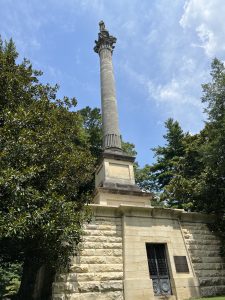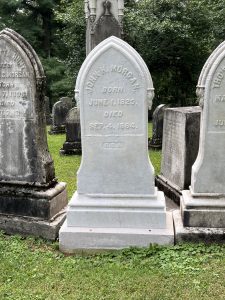A Bluegrass Sojourn to Lexington Cemetery
I recently had the pleasure of visiting Lexington, Kentucky to pay my respects to Henry Clay. This goal necessitated a trip to The Lexington Cemetery where I did not have to look long to find the iconic American statesman. His tomb is enormous and even with the many trees, it can be seen from a distance.

Born in Virginia in 1777, Clay became one of the most important statesman of his age. A lawyer who apprenticed with the likes of George Wythe (a signer of the Declaration of Independence), Clay moved to Kentucky and married Lucretia Hart. Elected by the Kentucky legislature to the U.S. Senate in 1806, he would begin a long career in national politics.
Over the course of a 40+ year career, Clay alternated between the House of Representatives, where he served several terms as Speaker of the House, and the Senate, the Kentuckian was also a three-time candidate for president.
Clay died in Washington, DC in June 1852 at the age of seventy-four after a long battle against tuberculosis. His tomb and mausoleum was built by the Clay Monument Association of Lexington and was completed in 1861.

Plainly visible from the gate, Clay’s sarcophagus is shaped like a coffin. Lucretia’s is off to the right side and not fully visible. The monument is topped by a statue of the blue-grass hero. According to a plaque on the monument, the building was renovated in 1976 and placed on the National Register of Historic Places – though it clearly is in need of repair now.
Not far from the “Great Compromiser,” were a some other notable graves. The one that drew my attention most quickly was a statue and grave of John C. Breckinridge. The statue portrays Breckinridge in the standard ortator’s pose of the 19th century in civilian garb. The statue formerly sat on the courthouse lawn in Lexington, but was moved to the cemetery in 2015. His nearby grave, I noted, was marked with an American flag – not a Confederate one.

Breckinridge might have enjoyed a rich reputation in American history – after all he was the youngest vice-president in American history (36). He served in both houses of congress and was a well-respected statesman until the Civil War when he was formally expelled from the United States Senate for joining the Confederate army.
The Kentuckian rose to the rank of Major General in the Confederate army with extensive field service. In January 1865, Jefferson Davis appointed Breckinridge Secretary of War. In April, Breckinridge was present at Bennett Farm in North Carolina when General Joe Johnston surrendered his army to Sherman.
Breckinridge went into exile abroad in 1865 and returned years later. He died from complications of old war wounds at the age of fifty-four. His legacy has been tainted by his Confederate service.
Interestingly, there is a solar-powered camera which monitors Breckinridge’s memorial, suggesting that it has been a target of vandals.
Another notable resident of Lexington Cemetery also served the Confederate cause and is as controversial as Breckinridge — John Hunt Morgan.

Morgan was born in Alabama in 1825 and saw service in the Mexican War. At the outset of the Civil War, the blue-grass businessman had been against secession. All the same in Morgan followed his brother into Confederate service raising the 2nd Kentucky Cavalry Regiment.
Best known as a raider, Morgan’s legacy centers on an ill-fated and – in fact, unauthorized – raid into Indiana in Ohio, which ended in his capture. Morgan escaped prison and returned to Confederate service – with a much-diminished reputation. He was killed by Union troops in Greeneville, Tennessee in September 1864.
Morgan’s tombstone, unlike the others near it, is a very clean white stone. This suggests that it was newly cleaned — or probably a replacement of an earlier stone. I suspect this would be an object of interest for vandals – though there is no camera monitoring the grave.
Established in 1848, The Lexington Cemetery is one that was established during the rural cemetery movement in 1848. This style cemetery, favored by Victorians, features extensive landscaping – including paths, ponds, and often fountains. It is on the National Register of Historic Places and is a wonderful place to wander on a hot summer afternoon.
I always say, if you are a Civil War buff, you’d better be ready to walk some cemeteries. It is not always an easy project when you don’t know the location of the grave you are looking for. This is a great article. Thanks.
The Lexington Cemetery is indeed a beautiful place, but if Confederate service or connections “diminishes” one’s reputation for you, don’t go there. Mary Todd Lincoln’s three brothers, “all confederate soldiers” as their joint gravestone specifies. Deo Vindice.
Deo Vindice
Just John H. Morgan – he never used Hunt. And the cemetery is indeed an amazing place, thanks for the post!
The article states that Breckenridge “died of complications from old war wounds.” When was Breckenridge wounded?
Is this where the relocated equestrian statue of John Hunt Morgan was placed ?
/Users/marthasobieszczyk/Pictures/Photos Library.photoslibrary/originals/F/F156B726-CC31-4B7D-B73A-5592FFE7D832.jpeg